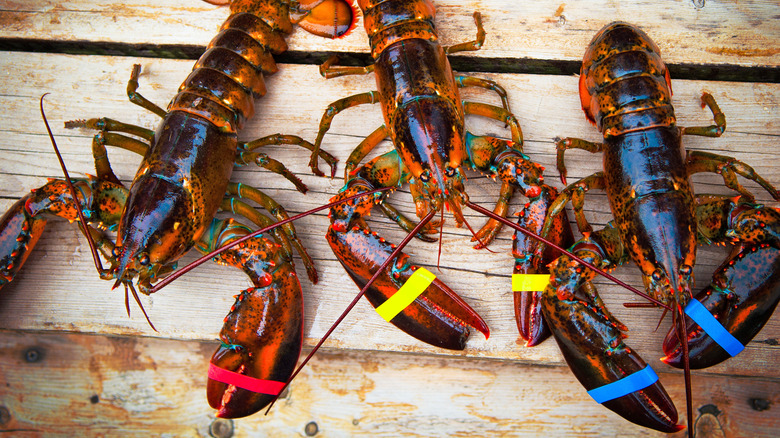Why You Should Always Buy Whole Lobster Fresh Not Frozen
As anyone who's ever tried it knows that cooking fresh lobster at home can feel a lot like the scene in 1977's masterpiece "Annie Hall" in which the protagonists, Annie and Alvy, lose control of their meal and end up with a kitchen floor scattered with lobsters. Then, to their horror, one lobster crawls behind the refrigerator. It doesn't have to be like this when preparing the crustaceans yourself at home — but it is important to buy your lobsters fresh, not frozen.
To be clear, "fresh" means alive, and while those moving claws might seem intimidating, but they're the least of your worries. Vibrio bacteria crave decaying shellfish and they can spread as quickly as Annie and Alvy's lobster spread across the kitchen floor. Within just a few hours of the lobster dying, its flesh decomposes and vibrio bacteria arrives — and you can't get rid of it through cooking. Ingestion of this bacteria induces nausea, fever, chills, and abdominal cramping, per the CDC.
From a culinary perspective, freezing also majorly decreases lobster meat's quality. Within just one hour of dying, the lobster's natural enzymes begin to break down, making the flesh structurally mushy. The claws and tails can be swiftly detached and frozen, but if you're cooking a whole lobster, prioritize safety and quality standards and opt for fresh.
Stay safe, inside the body and out
It is important to keep in mind that alive doesn't always equate to safe. To make sure your fresh lobster is okay to eat, lift it by its lower-middle body (aka the carapace). Healthy lobsters will reflexively wiggle their limbs and raise their claws above their heads. If a lobster doesn't move when you lift it, it's likely a sign that something is wrong.
The easiest way to get a fresh lobster home is to opt for a delivery service. Lobster Anywhere, Luke's Lobster, and The Lobster Guy can all get the job done. Get Maine Lobster is even a subscription service for frequent flyers. But, if you're in a pinch and need to get those freshies home yourself, transport them in a cooler and store them in the refrigerator wrapped in damp paper towels or in a cooler with ice packs when you get home (leave the lid off so they can still breathe). For added safety, pop lobsters in the freezer for a bit before handling. The low temperature will stun them, making them sluggish and sparing you from the receiving end of a claw.

